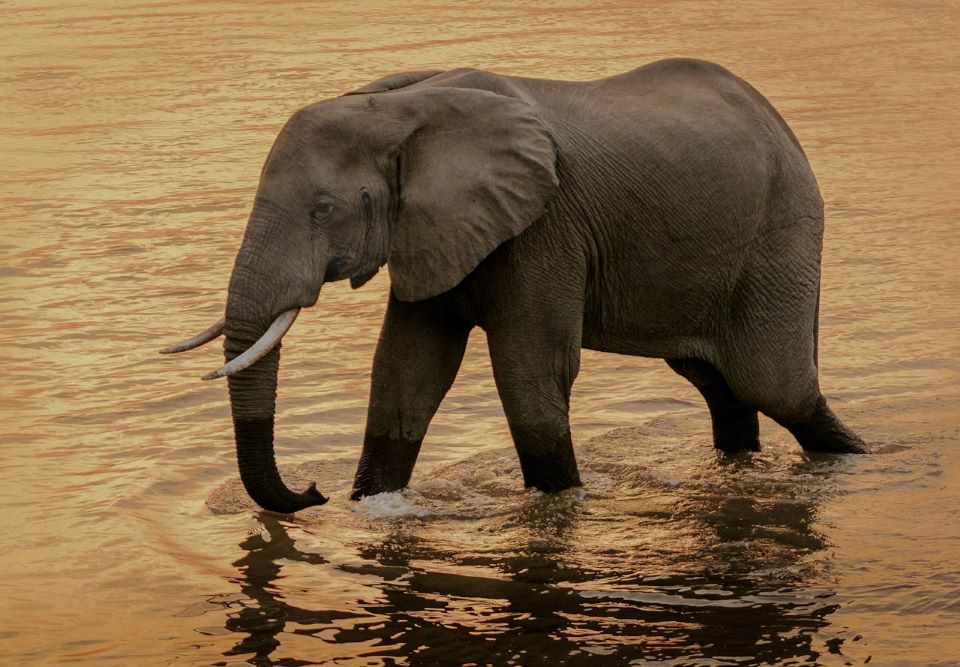The Land of the Tswana can be found in southern Africa where it finds itself bordered by other famous African game hunting destinations like Namibia, Zimbabwe, South Africa, and Zambia. A country of two landscapes and many big game hunting opportunities, Botswana is home to both dangerous African big game and plains animals alike.
Giving hunters the best of both worlds and some of the best game hunting outfits Africa has to offer, here’s why you should consider hunting in Botswana.
[DYNAMIC-BLOGTABLEOFCONTENT]
Botswana’s Rich Game Hunting History
Historically, Botswana’s hunting history (like many African nations) dates back to the times of the Bushmen and native populations who hunted for food and sometimes status; clothing themselves in sacred animal skins and horn accessories. Nowadays, hunting in Botswana is about the adventure, challenges, and rewards that await sport and trophy hunters the world over.
In the past, this destination had an on-and-off affair with the game hunting industry. Closed in 2014; reopened in 2019, and then bearing the brunt of the worldwide Covid pandemic, big game hunting in Botswana really got into the swing of things from 2021.
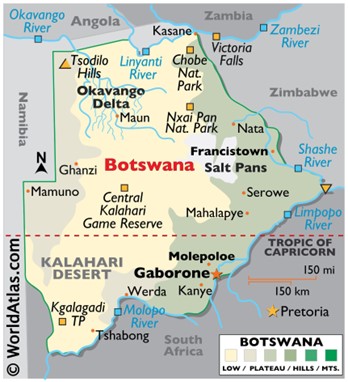
Big Game Hunting in Botswana – An Environment For Success
Botswana can be described as a land of opposites. On the one hand, you have a stretch of the Kalahari and an arid desert landscape; while on the other you have the Okavango Delta, one of the lushest and life-rich areas worldwide.
These opposites in terms of geographical landscapes lend themselves to the best of both worlds when big game hunting in Botswana. Both areas attract animal life in their ways. The Kalahari and Okavango each house species preferring their respective habitats, while at the same time, migration brings all the herds to the Delta in search of water, food, and even mating partners.
The Kalahari landscape is the dominant feature of Botswana’s geography and flows from the central to southwestern territories. But unlike other deserts marked by massive dunes, the Kalahari Desert is flat and marked by areas of thorny brush, rolling savannah, grassy plains, and even rocky outcrops. The region isn’t known for its great rains but does have a short rainy season to nurture the flora that feeds the plains.
The famous Okavango Delta occupies Botswana’s northwestern area and is known as a UNESCO World Heritage site. The Delta is famous for its seasonal floods which turn an otherwise dry land into a lush and green space that attracts thousands of animals during migratory periods. The Okavango also forms an endorheic basin, meaning no water flows out of it.
Due to its flat landscape, as the floodwaters recede, water is left in main channels and lagoons which draw animals back to the region as the seasons change.
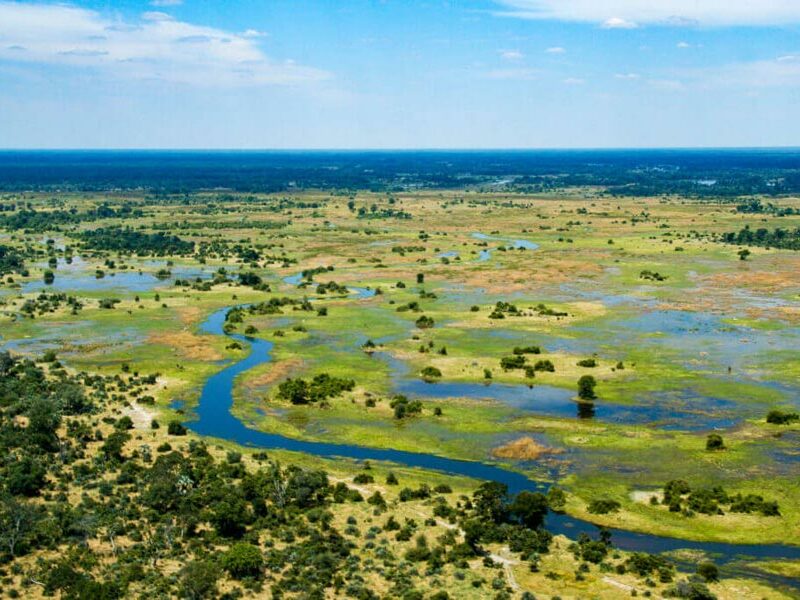
Species for Hunting in Botswana – African Big Game and More
Thanks to a diverse landscape, hunting safaris in Botswana can target a variety of big game hunting species and African plains game alike. Hunting safari needn’t have to travel from pillar to post either as Botswana hunting safaris for different species can take place within fairly close proximity to other areas.
Botswana is home to a variety of huntable African species and any hunter will be able to find the game hunting safari that suits their skills, desires, wallets, and preferred experience.
African Big Game
The Lion
Lion hunting safaris in Botswana offer hunters the dual opportunity of hunting in the Kalahari and Okavango Delta regions as both cater to a lion’s desired habitat. The Kalahari region provides arid, open landscapes with dry thorn brush, while the Okavango provides a reliable water source and a near guarantee of successful prey hunting.
It’s suggested that the best time for a lion hunting safari is the early morning hours when lions are more likely to be less alert and somewhat tired after a night of hunting or roving. When big game hunting in Botswana for lions, remember this animal lends itself to the broadside and frontal shots as a lion’s large, muscular body provides ample shot surface area to end in death as humane as possible.
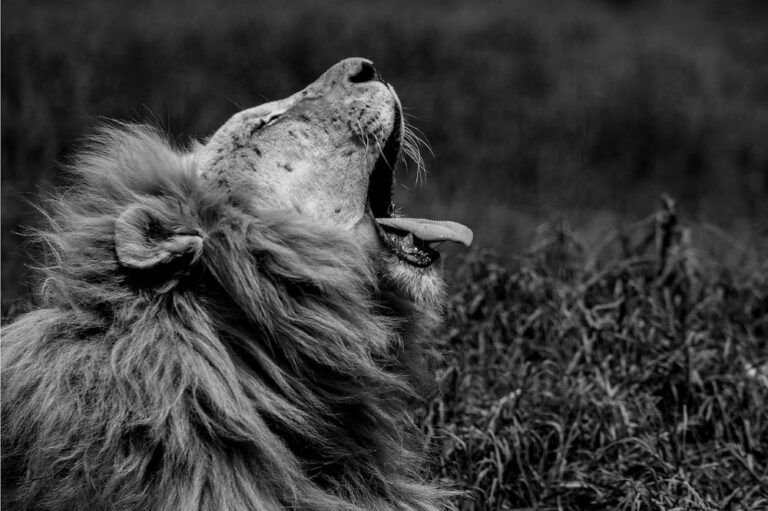
The Leopard
Leopard hunting in Botswana is said to be some of the best in the world. Taking place mainly in the Kalahari region, a leopard-hunting safari requires patience and soft-footed work. These big cats are known to be elusive and given their solitary nature, it takes time to find and track them.
Leopards lend themselves to both walk and stalk game hunting (especially in the Kalahari region) where Bushmen are employed due to their excellent tracking abilities; while in the Delta regions, a leopard hunting safari traditionally involves the use of a blind and bait.
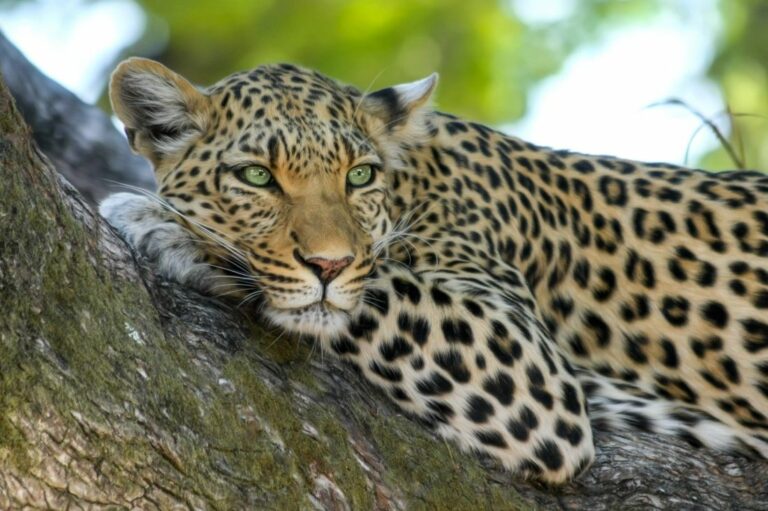
The Elephant
Botswana has the largest elephant population on the African continent and provides some of the most successful elephant hunting of all African game hunting destinations. Having reinstated their hunting safari industry surrounding this African big game in 2019 (after it was closed in 2014), Botswana now has an elephant population boasting a fair share of prime trophy opportunities.
At this point, elephant hunting safaris in Botswana are seen as a population control method, with the result of reducing human-elephant conflict, lessening the destruction of agricultural land, and even increasing habitat shares for other African big game and plains species alike.
The Nile Crocodile
The last of the living dinosaurs, the Nile crocodile makes its home in Botswana’s Okavango Delta. A hunting safari for this apex predator can commonly be done through the unique experience of hunting from a mokoro, a traditional canoe.
A crocodile hunting safari requires patience and skilled shot placement. The Nile croc has acutely trained senses and if simply wounded, will dive into the murky Delta depths, leaving the hunter high and dry to wait for the body to float up, or risk paying full price with nothing to show for their crocodile hunting safaris in Botswana.
Cape Buffalo
Given the open nature of game hunting areas in Botswana, buffalo roam freely around both the Okavango and Kalahari regions. The Delta provides a much-needed source of water and grazing ground within the marshes and lagoons, while the Kalahari environment offers open grassland, thorny brush, and mopane forest; providing these bad-tempered African big game with cover, and food sources when needed.
Cape buffalo hunting safaris in Botswana lend themselves to walk and stalk as well as the mokoro experience when hunting in the Delta’s waterways.
African Plains Game
The Sable
An antelope typically available for year-round hunting safari, sable hunting in Botswana often lends itself to the summer months when animals are drawn to the remains of the Okavango’s water supplies. In these times, cover from preying animals (and hunters) is sparser and gives better opportunities for spotting this striking antelope.
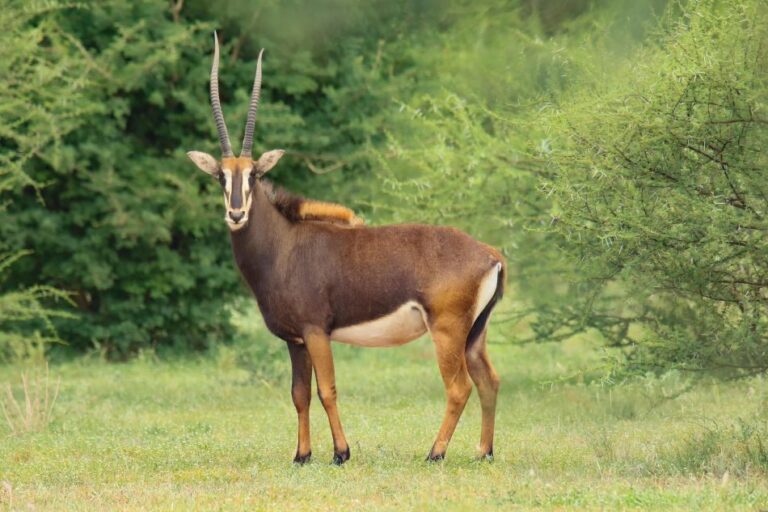
The Eland
These antelope are known to make a hunter pay their dues in walking and tracking. Eland hunting safari can trek on for hours due to their traveling nature and natural abilities at clambering hills and covering an expanse of ground in minimal time.
Game hunting for eland requires decent shot placement, as an injured eland is still capable of speeding off across the plains and scattering the herd.
The Kudu
Nicknamed the Grey Ghost due to their coloring (and shy nature), the kudu can be hunted from a blind at a watering hole or salt lick, as well as by spotting and tracking through the Kalahari landscape.
Kudu can be described as an African version of the elk, and a worthy hunting safari trophy includes an impressive set of distinctive spiral horns. Kudu are known to be excellent jumpers and when running off keep their heads tilted back to prevent those famous horns from tangling in trees or brush.
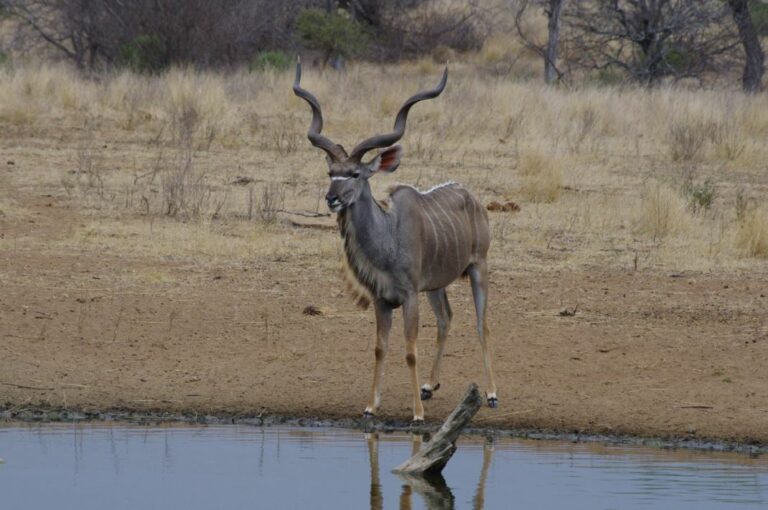
Gemsbok (Oryx)
A visually striking antelope, the Gemsbok has one of the most uniquely marked pelts of all African game hunting antelope. Gemsbok hunting safaris in Botswana favor the cooler months of the game hunting season when the temperatures are more comfortable to track in.
The most popular method for a Gemsbok hunting safari is the spot and stalk. A word of caution, due to their horns Gemsbok has the nickname Sabre Antelope. Those horns have been known to wound and even kill lions; exercise caution if you need to approach an injured Gemsbok, you wouldn’t want to deal with the Sabre experience.
Tsessebe
These social antelope can sometimes be found associating with gatherings of other African plains game like zebra and wildebeest. Another rather different-looking antelope, the tsessebe has the accolade of being the fastest antelope in Africa, capable of reaching over 50 miles per hour.
Tsessebe hunting safari can be built around their reliance on water and habit of feeding twice a day, mornings and afternoons once the heat of the midday has passed over. Shots tend to be longer in distance and require accuracy, you wouldn’t want to spook an animal capable of disappearing in the blink of an eye.
Warthog
This subspecies of bush pig can be found across Botswana; although populations lessen the further east a hunter travels, coinciding with the warthog’s love for open savannah plains and grassy areas.
Game hunting for warthogs often happens by accident as they are often spotted by hunters when tracking other animals. If targeting warthog specifically, the walk and stalk method of hunting safari is the best bet. Not the prettiest of African game hunting trophies, these social creatures can still make for a fun experience and unique trophy.

Black-backed Jackal
A territorial and fox-like animal, the black-backed or silver jackal is a specialty game hunting target to look for on hunting safaris in Botswana. Leaning more towards the Kalahari region, the black-backed jackal favors scrubland and savannah-type bush habitats.
While not the biggest of predators, these jackals will eat anything moving too slow and are known to target antelope like Dik-Dik, gazelle, and even impala by taking out the legs and eventually the throat. Smaller rifles work well on the jackal as well as the standard .375 recommended for broad use in African hunting.
Plains Zebra
Known for their horse-like appearance, zebra is one of the most recognizable trophies of African game hunting. Botswana is home to the 2nd largest zebra migration in the world, with hordes of up to 25,000 of these black and white-marked creatures finding their way to the Okavango Delta in search of water and grazing grounds. These migrations take place twice, with one migration moving between the Delta and Chobe region; while the other traverses the Delta – Makgadikgadi pan.
Zebra are a surprisingly robust and solidly built species and require a decent medium to heavy ammunition choice to fell them quickly and humanely
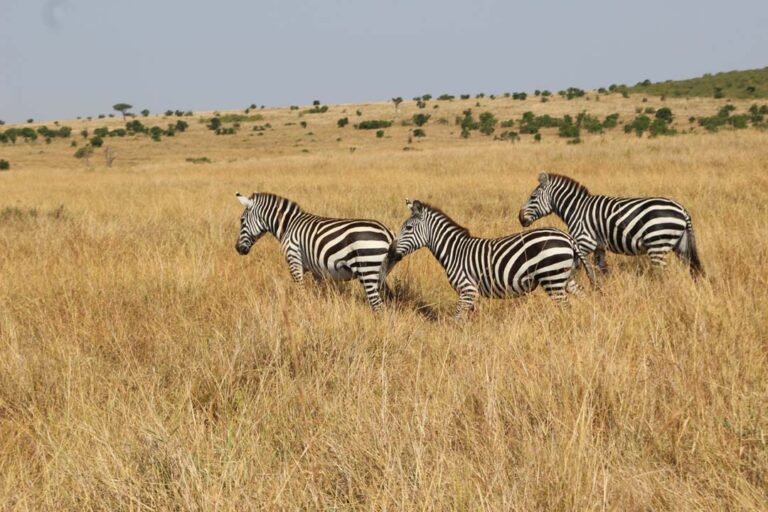
Methods for Hunting Safaris in Botswana
Walking or walk-and-stalk
These types of hunting safari typically start with a 4×4 drive from your hunting camp or resort to the area where your hunt is arranged. From here you will leave the vehicle and proceed on foot with the use of trackers, usually native Bushmen employed by outfitters.
This style can be used for both African plains game and big game hunting in Botswana, depending on your area and the advice of the PH and outfitter.
Spot-and-stalk
A spot and stalk hunting safari traditionally lends itself to the African plains game hunting side of hunting safaris in Botswana. These hunts also begin by vehicle, with the hunter, trackers, and PH doing periodic spotting or glassing until the desired targets are located. From here the hunting party will proceed on foot, much like in the above.
Blind
Game hunting by blind is the traditional choice for bow hunter hunting in Botswana. These blinds are typically erected near known watering holes or salt licks. When it comes to big game hunting in Botswana, this method lends itself to a leopard hunting safari where the blind will be erected near the bait site.
Mokoro
This traditional hunting safari practice dates back many years and is employed when hunting from the waters of the Okavango. Mokoro hunting can be used to target plains species on the banks or game hunting for the big boys of the water, Nile crocodile.
Mokoro hunting requires good shooting skills, balance, and sure footing as you might need to stand in the vessel to get a shot. The method can be used by both firearm and bowhunters alike.
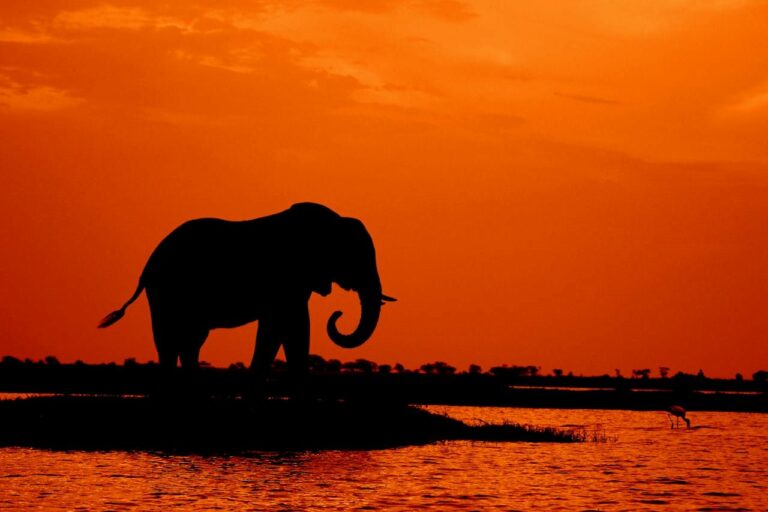
Big Game Hunting in Botswana – Bringing the (Big) Guns and More
Firearms
Hunting in Botswana will require you to adhere to the following criteria governing firearms and ammunition:
- Each hunter is allowed 3 firearms; 2 rifles and 1 shotgun, or 2 shotguns and 1 rifle.
- Rifles and shotguns must be of different calibers.
- 100 rounds of ammunition are allowed per firearm, more than enough for a standard game hunting safari.
- All ammunition must match the firearms.
- Handguns, military-style firearms, and all automatic/semi-automatic firearms aren’t allowed in Botswana.
- Each firearm requires its permit for entry in Botswana.
- When arriving in Botswana, you will be required to pay an import tax on all ammunition, and this may only be done in the local currency of the Botswana Pula.
When bringing your firearms on hunting safaris in Botswana, you will be required to complete a Botswana Firearms Permit Application. The outfitter can do this on your behalf, as long as they are provided with the following documentation:
- Letter of Proxy
- Certified copies of a hunter’s passport and proof of ownership papers for each firearm
- US Hunters must provide a US Customs 4457 form, while non–US hunters must produce their Firearms Permit or License.
- It is strongly recommended that the above documentation be carried with you at all times when hunting in Botswana, preferably in your gun case.
It is advised that firearms paperwork gets handled well in advance of your Botswana hunting safari
Bow Hunting
Hunting safaris in Botswana can be conducted with bowhunting, however, they don’t appear to have any formal guidelines surrounding this type of “ammunition” and it’s recommended to make use of the basic guidelines used in other African game hunting destinations:
|
Small Game |
Medium Game |
Big Game* |
|
Springbok, Jackal, Caracal, Warthog etc. |
Oryx, Kudu, Tsessebe, Sable, Eland etc. |
Buffalo, Lion, Leopard, Elephant, Crocodile, Hippo etc. |
|
40 ft./pound |
70 ft./pound |
80ft./pound |
|
400 grain |
550 grain |
700 grain |
* The hunting of African big game like those mentioned above is illegal in Botswana. Big game hunting in Botswana of the above-named animals must be carried out through the use of firearms only.
* No permit is required for the importing of Bow hunting equipment into Botswana.
A Glance At Hunting in Botswana
- Botswana’s game hunting season differs slightly depending on the classification of the area you’ll be hunting in:
- Community and Natural Resource Management Areas – April to September
- Private game ranches – year-round
- Unlike areas such as Tanzania, Botswana’s government doesn’t set minimum lengths for hunting safari. Any minimums will be set by the outfitter depending on the hunt.
- All hunting of African big game and other species is regulated by fair chase principles.
- When hunting in Botswana, no animal may be shot from a vehicle. Likewise, no juveniles, pregnant females, or nursing females may be hunted.
- The use of bait can only be employed when on a leopard hunting safari.
Hunting in Botswana is an exciting combination of exceptional trophies and diverse locations. A hunting safari to this dangerous game hunting destination is definitely worth adding to your bucket list!
Author: A. Baker
